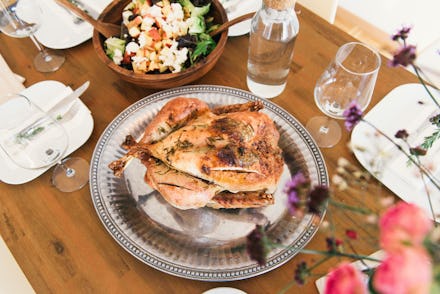The truth behind the food at Thanksgiving, one of the most mythical meals in America

After spending November tracing their hands to make five-feathered turkeys and maybe cutting some pilgrim hats out of construction paper, pretty much every elementary student in America is indoctrinated with the legend of the pilgrims and Native Americans harmoniously gathering together for a feast of turkey and friendship. Sorry to rain on the parade, America — but this beloved, rosy tale is just a fantasy.
As historian Andrew Beahrs explained on NPR, about 50 pilgrims met with about 90 members of the Wampanoag tribe for a three-day event in the fall of 1621. This gathering later became known as the first Thanksgiving, though it was was hardly a family-friendly affair.
First, it's presumed that only men were invited to this political gathering, which was intended to create a military alliance between the Wampanoag men and the English. And while the men were eating and theoretically becoming allies, guess who was doing all the cooking and cleaning? Women, of course.
And what eventually followed the feast was even more grim: indigenous genocide.
A national day of fasting, rather than feasting, has recently been proposed by social justice advocates to acknowledge the strife and racism that occurred following the first Thanksgiving — but in America, feasting prevails.
Why did Thanksgiving become "Turkey Day"?
Though turkey is the most iconic Thanksgiving food, Beahrs, along with several culinary historians, doesn't believe that turkey was actually on the menu at the first Thanksgiving. Venison, from deer gifted by Wampanoag guests, was certainly served, and Beahrs speculates that the fowl the English served were "probably migrating waterfowl like ducks and geese, which were plentiful in autumn."
While turkey was probably not eaten at that fateful Thanksgiving in 1621, New Englanders in the colonies and budding American South continued to celebrate days of Thanksgiving, as Andrew F. Smith explained in his book The Turkey: An American Story. And at these feasts, turkey began to rise in popularity.
Records from the early 18th Century document turkey being served on thanksgiving tables, and by 1792, a Connecticut newspaper estimated that 85,694 turkeys and geese were eaten by New Englanders on Thanksgiving (along with 128,541 chicken pies and 514,164 mince pies). Turkey began to rise in popularity and by the early 19th Century, "not every Thanksgiving dinner featured a turkey, but those that did not were exceptions," Smith wrote.
By 1863, the year that Abraham Lincoln proclaimed the last Thursday in November to be a national day of Thanksgiving, turkeys were already commonplace in family thanksgiving celebrations, so you can see how the turkey stuck around to make its mark on Turkey Day.
The traditional Thanksgiving sides are also based in myth
Green bean casserole and creamed spinach certainly weren't served at the first Thanksgiving (though stuffed birds do date back to Ancient Roman times and could have been served in America's early days). Because the first Thanksgiving was in Massachusetts, seafood like oysters and oyster stuffing were likely to have had a prominent place on the pilgrims' table, though the tradition of eating shellfish on Thanksgiving hasn't really stuck around.
Today's common, starchy sides, like potatoes and mac and cheese, aren't pilgrim or Native American fare, but rather dishes dating back to antebellum America, when enslaved Africans would cook for white families during the autumn harvest festivals. (Thanksgiving was not yet an official holiday.)
"It goes without saying that much of 'white Southern' holiday food owes its savor to the influence of black cooks and living in the vicinity of black cultures," culinary historian Michael Twitty wrote in the Washington Post. Though some side dishes may have antebellum roots: "Some represent the glory of freedom, with deviled eggs and macaroni pie (the old Southern and Caribbean name for mac and cheese) being a prime example of the eggs, pasta and cheese that rarely if ever were enjoyed under the lash," Twitty wrote.
And that legendary green bean casserole? Created in the 1950s by a young woman, Dorcas Reilly, with a degree in home economics and a job in the Campbells Soup Co. test kitchen, some grandparents at Thanksgiving may outdate green bean casserole, but the marketing made the gooey vegetable dish an instant classic. That's America for you.
But wait, is chili a Thanksgiving food?
Some usher in Thanksgiving with a warm bowl of chili and a cold bottle of beer in front of a series of NFL games. The spicy meat-and-bean dish (regardless of whether it's consumed while watching adults wrestle each other for a ball) could actually be more patriotic than one might assume.
The United States of America was not an independent nation until 1776, and if we're interested in eating like the immigrants of the 17th century, when the o.g. Thanksgiving feast took place, shouldn't we expand to other parts of the country-to-be?
In her book Eight Flavors: The Untold Story of American Cuisine, author Sarah Lohman writes about the origins of American cuisine circa 1621:
While the English immigrants celebrated the end of their first year in Plymouth, Spanish immigrants were establishing missions in what is today the American Southwest. When Texas became pat of the United States, the people that lived there had a culture that became a part of the American story, just like the Mayflower. A bowl of chili, drawn from Mexican heritage, influenced by the Germans and made famous in the state of Texas, is a true American dish.
Since chili is so uniquely American, it seems like the spicy, meaty stew should certainly have between placed next to the cornbread and gravy boat. Turkey chili, anyone?